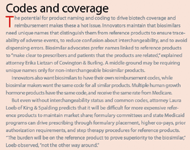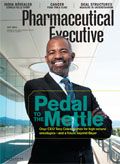Battles over Biosimilars
Pharmaceutical Executive
Sponsors must handle interchangeability, exclusivity, cost and coverage hurdles to win biosimilars game
The only area of agreement about developing and regulating follow-on biotech therapies is that the process is more complex and more costly than for conventional generic drugs, and that the Food and Drug Administration (FDA) will require more testing to label a product biosimilar or interchangeable. Developing a biosimilar will cost $75 million to $250 million and take seven to eight years, according to those experienced in the field.

Jill Wechsler
Even so, the growth prospects for biopharmaceuticals makes follow-on development increasingly attractive to diverse players. The worldwide market for biosimilars is projected to grow to $3.7 billion by 2015, up from about $250 million last year, reports Datamonitor. As more biotech patents expire and regulatory authorities clarify the rules, development of copycat therapies is slated to soar. Payers talk of biosimilars offering discounts of 25 percent to 30 percent off brands, but reimbursement experts say that prices that are just 10 percent lower will be able to gain market share, particularly for therapies with high price tags to begin with (see sidebar).

Codes and coverage
Setting a Pathway
FDA officials are under pressure from Congress, government agencies, and payers to develop an abbreviated regulatory pathway for approving biosimilars, as authorized by the Biologics Price Competition and Innovation Act (BPCIA), part of the Affordable Care Act of 2010. The legislation aims to reduce spending on pharmaceuticals by bringing "highly similar" versions of biotech therapies to market based on less extensive preclinical and clinical testing than was required to approve the original reference product.
The challenge for FDA is to establish science-based standards for documenting biosimilar safety, purity, and potency that acknowledges reference drug data and market experience. FDA held a public meeting in November 2010 to launch the process for establishing a biosimilar testing process to ensure there are no "clinically meaningful differences" between the new biologic and the reference product; the new drug has to use the same mechanism of action and have the same route of administration, dosage form, and strength. Janet Woodcock, director of the Center for Drug Evaluation and Research (CDER), recently indicated that general guidance should appear this year, and that its requirements for human testing will vary according to how well a biosimilar can document sameness to the innovator product. Although biosimilars generally will need additional clinical studies to document equivalent efficacy in at least one approved indication, even innovator firms acknowledge that the biosimilar pathway will involve less animal toxicity testing and probably no dose finding or Phase II clinical studies.
Another key step is to set a user fee schedule for biosimilars. The agency has proposed application fees similar to those for innovator drugs and biologics, but with a new approach to help finance FDA involvement in steering sponsors through the development process. The plan is for companies to pay a product development fee of $150,000 when it submits an investigational new drug application and annually thereafter; those upfront payments then will be subtracted from the eventual application fee.
Even without final guidance, FDA officials say they're ready to evaluate biosimilar applications on an individual basis. "We were open for business a year ago," said Steven Kozlowski, director of CDER's Office of Biotechnology Products, at a May biosimilars conference, jointly sponsored by the Drug Information Association (DIA) and the Food and Drug Law Institute (FDLI). So far no manufacturers have attempted the 351(k) approval route authorized by the BPCIA, but many are talking to FDA and considering their options.
Meanwhile, FDA is tackling some very basic issues, such as which products fall under the new regulatory program. The BPCIA redefines most proteins as biologics, beginning in March 2020. FDA thus has to set new policies for manufacturers of proteins long regulated as drugs and address the nine-year transition period.
Another thorny topic is whether FDA can approve a biosimilar based on a reference product that is approved overseas, but not in the US. The BPCIA says that reference products have to be licensed by FDA, but biosimilar makers want flexibility to permit comparison to a biologic licensed by a foreign regulatory body. This is important for global biosimilar development programs, pointed out John Pakulski, head of US biopharmaceutical regulatory affairs at Sandoz, at the DIA/FDLI conference. He and others propose to permit the use of foreign reference products that are made by a US manufacturer or in a facility inspected by FDA; licensed in highly regulated markets such as Europe or Japan; or present sufficient postmarketing history to confirm safety, purity, and potency. Additional scientific data could be required on a case-by-case basis to establish comparability between a US and foreign-sourced reference product.
Also contentious is whether biosimilar sponsors can extrapolate data from a clinical study to other indications of the reference product. European regulatory authorities permit this if the added indication involves the same mechanism of action and same receptor, and if extrapolation of immunogenicity data applies to a lower-risk population or route of administration. Biosimilar sponsors want a similar approach from FDA, probably with support from open-label safety studies for each indication.
Interchangeability and Exclusivity
Equally challenging for FDA is to define interchangeability testing requirements and whether clinical switching studies will be required to meet that standard. An interchangeable designation is important because the first follow-on biologic so deemed by FDA enjoys a year of market exclusivity, during which FDA may not approve another similar interchangeable product.
Biosimilar makers note that switching studies are not required for innovator manufacturers to document comparability following post-approval changes. Yet, innovators maintain that clinical studies in multiple populations are necessary to ensure safety and efficacy with product switching. Amgen vice president Anthony Mire-Sluis pointed out that head-to-head studies are needed to compare immunogenicity between reference and follow-on products, and that product labels should explicitly state approved indications and whether the biosimilar is interchangeable for that indication.
Although the BPCI authorized 12 years' exclusivity for innovator biologics, that has not ended the exclusivity debate. In addition to the 12 years when FDA cannot approve another product based on innovator data, biosimilars sponsors have to wait four years after BLA licensing to even submit a 351(k) application. Innovators claim these protections are needed to spur investment in R&D, but critics claim that 12 years is too long. The Obama administration recently proposed reducing exclusivity to seven years, largely to cut spending, but also to prevent patent "evergreening." Biosimilars makers fear that innovators will seek to extend protections by modifying a reference product's safety, purity, or potency sufficiently to make it "new." The change has to be significant, says Kozlowski of CDER: "I don't think that 'slightly better purity' is enough to extend exclusivity," he observed at the DIA/FDLI conference.
As with conventional generics, everyone is bracing for extensive legal maneuvering over patent and exclusivity issues. The BPCIA took FDA out of the patent-listing arena, but set up an even more complex process for dealing with patent disputes: Biosimilars makers have to provide the reference product sponsor with a full dossier on its process and product so that the innovator can determine which patents it feels may be infringed. This "hokey-pokey process," explained Sidley Austin attorney Jeffrey Kushan, was designed to promote early agreement on which patents are worth fighting about, but appears likely to create a highly competitive legal environment. Biosimilars makers fear that too many parties will gain access to their confidential filings, while BLA-holders stand to lose protection if they miss a deadline.
If the biosimilars regulatory process appears too complex and costly, it may limit the value of the 351(k) procedure and make the traditional BLA route to market—and its 12 years' exclusivity—the more attractive option for copycat biotech developers.
Jill Wechsler is Pharmaceutical Executive's Washington correspondent. She can be reached at jwechsler@advanstar.com

FDA Approves AbbVie’s Rinvoq as First Oral JAK Inhibitor for Giant Cell Arteritis
April 30th 2025AbbVie secures FDA approval for Rinvoq as the first oral Janus kinase inhibitor indicated for giant cell arteritis, expanding its immunology portfolio and signaling strategic growth opportunities in underserved autoimmune markets.
Addressing Disparities in Psoriasis Trials: Takeda's Strategies for Inclusivity in Clinical Research
April 14th 2025LaShell Robinson, Head of Global Feasibility and Trial Equity at Takeda, speaks about the company's strategies to engage patients in underrepresented populations in its phase III psoriasis trials.